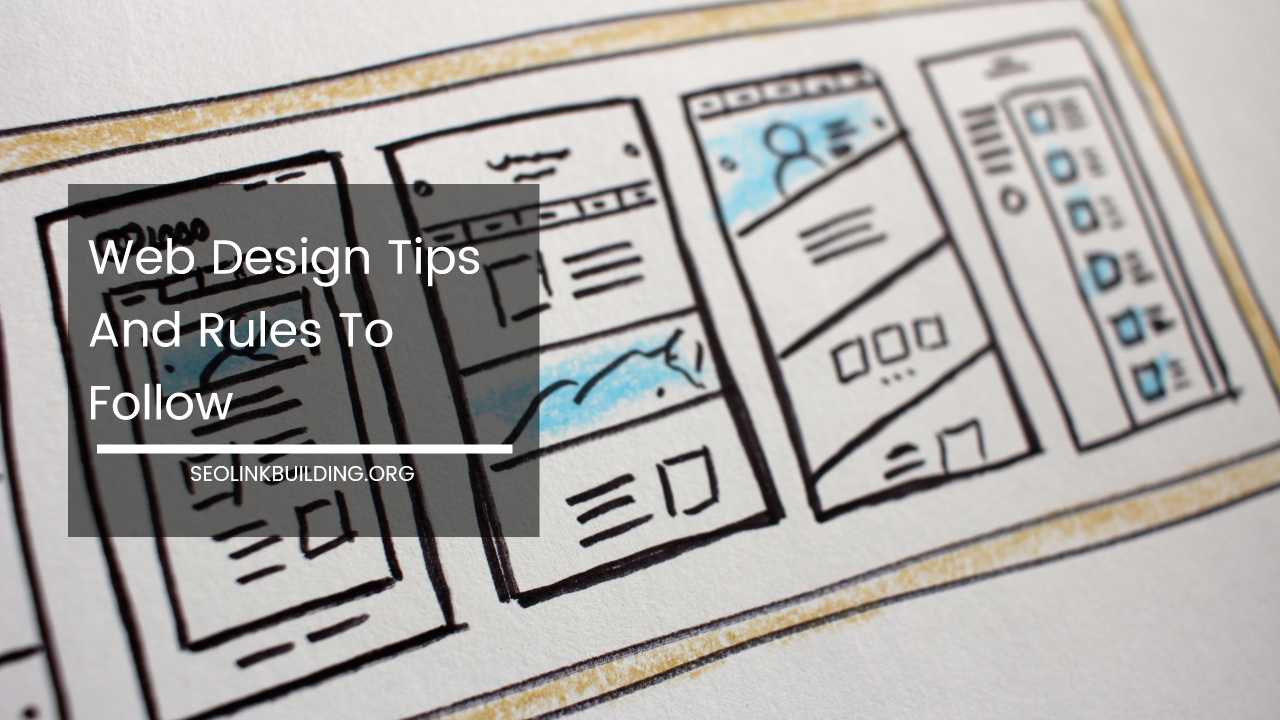Web Design Tips and Rules to Follow

Web Design Tips and Rules to Follow for a Winning Website
In today’s digital landscape, your website is more than just an online brochure; it’s a dynamic platform that fosters connections, drives conversions, and establishes your brand identity.
A well-designed website goes beyond aesthetics, offering an intuitive user experience (UX) that compels visitors to explore, engage, and ultimately achieve your desired goals.
Whether you’re a seasoned web professional or just starting your development journey, understanding core web design principles is essential for crafting a website that stands out in the ever-crowded digital space.
This comprehensive guide delves into essential web design tips and rules, empowering you to create a website that not only looks great but also converts visitors into loyal users or paying customers.
Know Your Audience and Purpose: The Foundation of Success
Before diving headfirst into design elements and visual flourishes, take a step back and identify your target audience and the website’s primary purpose. Who are you trying to reach? What information or action do you want them to take on your website?
-
Target Audience: Understanding your ideal user demographics, interests, and online behavior is crucial. Are you targeting busy professionals seeking financial advice or young tech enthusiasts exploring the latest gadgets? Tailoring your design and content to resonate with their specific needs and expectations is essential. Conduct market research, analyze competitor websites, and consider creating user personas to gain a deeper understanding of your target audience.
-
Website Purpose: What is the main objective of your website? Is it to generate leads for your business, sell products online, showcase your creative portfolio, or provide educational content in a specific niche? Having a clear purpose will guide your design decisions, content strategy, and ultimately the success metrics you use to evaluate your website’s performance.
Prioritizing User Experience (UX): Creating a Seamless Journey
Your website should be a user-friendly haven, not a confusing maze that frustrates visitors and sends them bouncing away. Here’s how to prioritize a seamless UX:
-
Simple and Intuitive Navigation: Strive for clear and concise navigation menus. Users should be able to find the information they need within a few clicks. Organize your navigation structure logically, categorizing content in a way that is intuitive for your target audience.
-
Mega Menus for Extensive Content: For websites with a vast amount of content, consider using mega menus. However, ensure they remain uncluttered and well-organized. Utilize subcategories, clear labels, and hover effects to make navigation efficient.
-
Breadcrumbs for Deeper Pages: Implement breadcrumbs, a navigational element that indicates a user’s location within the website’s hierarchy. This helps users understand their current position and allows them to easily navigate back to previous sections.
-
-
Visual Hierarchy and Readability: Guide users’ eyes through your content using visual hierarchy. Place the most important information at the top of the page and use elements like size, color, and negative space to establish a clear reading flow. Employ easy-to-read fonts with sufficient contrast against the background color. Consider using dyslexia-friendly fonts for an inclusive approach.
-
Mobile-Responsiveness: A Must-Have in Today’s World: In today’s mobile-first world, a website that doesn’t adapt to different screen sizes is a major turn-off for a significant portion of your target audience. Ensure your website displays flawlessly across desktops, tablets, and smartphones. Utilize responsive design techniques or consider building a separate mobile website to deliver an optimal user experience on all devices.
-
Fast Loading Speed: Keeping Users Engaged: Nobody enjoys waiting for a website to load. Optimize images by reducing their file size without compromising quality. Minimize HTTP requests by combining files and leveraging caching mechanisms. Implementing a Content Delivery Network (CDN) can further improve website loading speed by delivering content from geographically distributed servers.
Visual Appeal Matters: Creating a Website That Captivates
While prioritizing user experience is paramount, visual appeal shouldn’t be neglected. A website that is both informative and aesthetically pleasing creates a positive first impression and keeps users engaged for longer. Here’s how to achieve this balance:
-
High-Quality Images and Graphics: Visuals are powerful tools for conveying information, grabbing attention, and evoking emotions. Use high-quality, relevant images and graphics that complement your brand identity and content. Stock photos can be a great resource, but consider utilizing original photography or custom-designed graphics to truly stand out.
-
Color Scheme: Setting the Tone Colors evoke emotions and set the tone for your website. Choose a color scheme that aligns with your brand identity and resonates with your target audience. Consider color psychology principles when making your selections. For example, blue is often associated with trust and security, while red can convey excitement or urgency.
- Color Accessibility: Ensure your website adheres to accessibility guidelines by providing sufficient contrast between text and background colors. Tools like WebAIM’s Contrast Checker can help you evaluate color contrast ratios. This is crucial for users with visual impairments and creates a more inclusive user experience.
-
White Space (Negative Space): Effective Use of Emptiness White space, or negative space, is the empty space between design elements. It’s not wasted space; it provides breathing room for your content and visuals, preventing the website from feeling cluttered and overwhelming. Utilize white space strategically to guide the user’s eye and highlight important elements.
-
Consistent Branding: Building Recognition and Trust Maintain a consistent brand identity throughout your website by using the same color scheme, fonts, logos, and overall design aesthetic across all pages. This reinforces brand recognition and builds trust with visitors. Consider developing a brand style guide to ensure consistency across various marketing materials.
Content is King (and Queen): The Power of Words
Compelling and informative content is the backbone of any successful website. High-quality content not only engages users but also establishes your expertise and authority in your field.
-
Clear, Concise, and High-Quality Content: Write clear, concise, and error-free content that is easy to understand for your target audience. Avoid jargon and technical terms unless absolutely necessary, and break up large chunks of text with headings, subheadings, and bullet points for improved readability.
-
SEO Optimization: Reaching the Right Audience Integrate relevant keywords throughout your website content to improve search engine ranking and ensure your website shows up in search results for queries related to your niche. However, prioritize natural language over keyword stuffing. Conduct keyword research to identify relevant search terms and use them strategically within your content.
-
Calls to Action (CTAs): Guiding Users Towards Conversion Tell visitors what you want them to do next. Whether it’s subscribing to your newsletter, making a purchase, or contacting you, use clear and concise calls to action (CTAs) that stand out visually. Experiment with different CTA button styles, colors, and placement to find what resonates best with your audience.
-
Regularly Updated Content: Keeping Your Website Fresh Fresh content keeps users engaged and demonstrates your expertise in your field. Regularly update your website with new blog posts, articles, product information, or case studies.
Technical Considerations: The Foundation of a Secure Website
Beyond aesthetics and content, there are crucial technical aspects to consider to ensure a smooth user experience and website security.
-
Website Security: Protecting User Data and Reputation Implement strong website security measures to protect user data and prevent cyberattacks. Consider using an SSL certificate to encrypt sensitive information like credit card details and login credentials. Regularly update your website’s software and plugins to address security vulnerabilities.
-
Website Performance Optimization: Keeping Things Speedy Beyond initial loading speed, consider website performance optimization for a seamless user experience. This includes optimizing code, minimizing server response times, and enabling browser caching. Tools like Google PageSpeed Insights can help you identify areas for improvement.
-
Accessibility: Catering to Diverse Users Make your website accessible to users with disabilities by following Web Content Accessibility Guidelines (WCAG). This includes providing alternative text descriptions for images, ensuring keyboard navigation functionality, and using clear and concise language.
-
Analytics and Tracking: Measuring Success and Making Improvements Integrate website analytics tools like Google Analytics to track user behavior, identify website performance metrics, and gain valuable insights into how users interact with your website. Use this data to make informed decisions about website design, content strategy, and overall user experience.
The Final Touches: Going Beyond the Basics
Once you’ve mastered the core principles of web design, consider these additional elements to elevate your website and set it apart from the competition:
-
Microinteractions: Adding Delightful Details Microinteractions are subtle animations or interactions that add a touch of delight and user engagement. For example, a button that subtly changes color on hover or an animation that displays when a form is submitted successfully.
-
Interactive Elements: Encouraging User Participation Incorporate interactive elements like quizzes, polls, or calculators to encourage user participation and keep them engaged for longer.
-
User Reviews and Testimonials: Building Trust Showcase user reviews, testimonials, and case studies to build trust and credibility with potential customers.
-
Multilingual Support: Reaching a Global Audience If your target audience extends beyond a single language, consider offering multilingual support on your website. This can significantly increase your reach and brand awareness.
Conclusion: Building a Winning Website – A Continuous Process
Creating a winning website is an ongoing process that requires continuous iteration and improvement. By understanding and applying the core principles outlined in this guide, you’ll be well-equipped to craft a website that not only looks great but also delivers a seamless user experience, achieves your desired goals, and ultimately contributes to your online success. Remember, the following aspects are crucial for maintaining a winning website:
-
Stay Informed About Design Trends: The world of web design is constantly evolving. Stay informed about the latest design trends and best practices by following industry publications, attending design conferences, and subscribing to design blogs. However, avoid blindly following every trend; prioritize user experience and brand alignment when making design decisions.
-
A/B Testing for Optimization: Utilize A/B testing to compare different versions of website elements and identify what resonates best with your audience. This could involve testing variations of headlines, CTAs, color schemes, or page layouts. A/B testing allows you to data-driven decisions to optimize your website for conversions.
-
Regular Maintenance and Updates: Regularly maintain your website by fixing broken links, updating content, and addressing any security vulnerabilities. Consider implementing a content management system (CMS) to simplify the process of updating your website.
-
Embrace User Feedback: Actively solicit user feedback through surveys, contact forms, or social media interactions. Analyze this feedback to identify areas for improvement and make adjustments to enhance the user experience.
Incorporating these ongoing practices will ensure your website remains fresh, relevant, and continues to deliver exceptional value to your target audience.
By following the web design tips and rules outlined in this comprehensive guide, you’ll be empowered to create a website that serves as a powerful cornerstone for your online presence. Remember, a winning website is a journey, not a destination. Embrace the process of continuous learning, adaptation, and improvement to keep your website thriving in the ever-evolving digital landscape.













